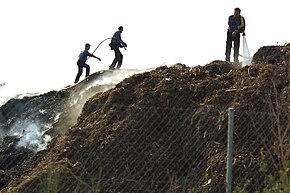
Spontaneous combustion or spontaneous ignition is a type of combustion which occurs by self-heating (increase in temperature due to exothermic internal reactions), followed by thermal runaway (self heating which rapidly accelerates to high temperatures) and finally, autoignition.[1] It is distinct from (but has similar practical effects to) pyrophoricity, in which a compound needs no self-heat to ignite. The correct storage of spontaneously combustible materials is extremely important considering improper storage is the main cause of spontaneous combustion. Materials such as coal, cotton, hay, and oils should be stored at proper temperatures and moisture levels to prevent spontaneous combustion. Allegations of spontaneous human combustion are considered pseudoscience.[2]
- ^ Babrauskas 2003, p. 369
- ^ Radford, Benjamin (19 December 2013). "Spontaneous Human Combustion: Facts & Theory". Live Science.
Yet all these explanations are pseudoscientific, and there is no evidence for any of them